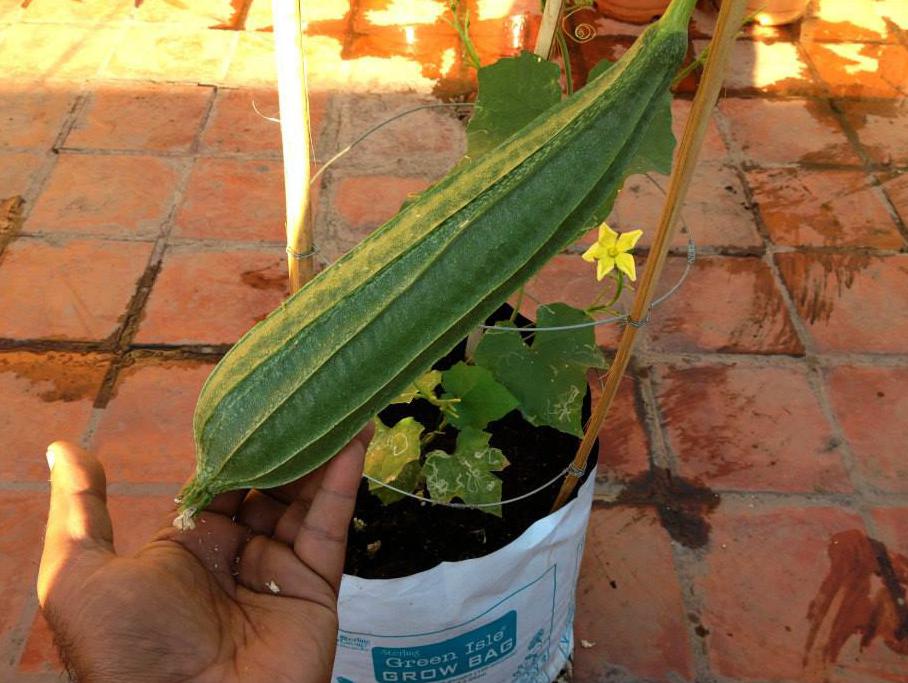Ridge Gourd Plant Overview
Ridge gourd (L. aegyptiaca) is an annual, vigorous, climbing vine, with yellow flowers. It is best consumed when still tender and green. It may be allowed to mature, cleared of all seeds, and used as a bath or kitchen sponge, also known as loofah.
This document focuses on growing Ridge Gourds.
Table 1 Planting Guide
|
Depth to plant |
1/2 inch deep |
|
Spacing between seeds |
Space plants about 5'' apart |
|
Spacing between seedlings |
Space rows about 3'' apart |
|
Days to germinate (Sprout) |
7 - 14 days |
|
Planting season |
Summer Spring |
|
Plant height |
Grows as a vine |
|
No. of Plants per sq. ft. |
1 plant per sq. ft. |
|
Soil requirement |
Prefers soil with pH levels of 5.5 - 6.8. |
Ridge Gourd Plant Prerequisites
- Plant Type: Perennial grown as an annual plant
- Light: Full sun
- Water: When it comes to watering ridge gourds in container gardens, keep the potting soil constantly moist.
Ridge Gourd Growing Steps
The following steps define the process from seed to harvest.
1. You must sow the heirloom seeds of ridge gourds from My Green Vault in pro trays and then transplant. For more information on sowing seeds and germination tips, refer to ***.
2. Prepare your ridge gourds for transplanting once the plants have reached at least 1/2-foot in height.

3. Prepare a good growing medium. A good, simple option is a mix of two parts potting soil, one part Coco Peat (CP) and one part Vermi Compost (VC). The soil and VC provides your plant with the nutrients it needs, while the CP mix retains the moisture.

4. Place your pot in a sunny location and ensure to provide adequate support system (trellis)

Note: Without any support, your ridge gourds will have very little upward growth and, as a result, they may not yield.
Ridge Gourd Plant Maintenance
Ridge gourds require evenly moist soil to ensure the best and fast growth. Do not over water or allow the soil to dry out.
Tip: As the plant grows, you can observe tendrils, a specialized stem with a threadlike shape. These are used by the climbing plants for support by twining around nearby hosts. You can nip off all the tendrils. We do not need them as we will provide support and guide the plant on the trellis.
Pollination in ridge gourds or for that matter, any type of gourds, can be quite tricky! So, a brief description on the flowers and pollination is provided.
• Ridge gourd flowers
• Ridge gourd pollination
1. Ridge gourds are heavy feeders. When your ridge gourds bloom, to help promote greater plant productivity, add adequate amount of VC or Compost Tea (CT).

Note: For more information on CT preparation and application, refer to ***. 2. Make sure your ridge gourds receive at least 1“-1 1/2” of water a week.
3. Once the soil has warmed, ensure to retain soil moisture and an even growing temperature around the plant.
Ridge gourd flowers
Ridge gourds produces both male and female flowers. The female flower develop into ridge gourd, and this sets them apart from their male counterparts.
Ridge gourd pollination
Honey bees and some insects help in pollinating the flowers. Sometimes, none of the female flowers produce fruits, but drop off without growing into a ridge gourd. This is mainly due to the failure of pollination. Even though nature does its magic everyday, its absolutely normal to go ahead and hand pollinate the ridge gourd.
How? Very simple!
When the flowers open, rub a soft brush, first in the male flower and then in the female flower.
Tip: I have also succeeded by rubbing softly the inside of both the flowers together.
Ridge Gourd Companion Plants
• Bottle gourd, bitter gourd, cucumber.
Ridge Gourd Plant Protection
Ridge Gourd Pests
Ridge gourds can be attacked by the following:
• Fruit fly
• Beetles and caterpillar
Ridge Gourd Diseases
- Powdery mildew
- Downey mildew
Ridge Gourd Organic Control
Once you have identified the troublemakers, you can control them with an assortment of organic pest-control methods. The following list contains few methods:
a. Beetles and caterpillars
– Hand pick off the plants
– Dislodge with jet water spray
b. Fruit fly
– Set up pheromone trap at 12 numbers per hectare.
– Remove the affected fruits and destroy
c. Downey mildew
– Prune or stake plants to improve air circulation
– Water only in the morning so plants have a chance to dry during the day
d. Powdery mildew
– Mix 1 part milk with 9 parts water and spray the stems and tops of leaves with the solution. Reapply after rain.
– Spraying leaves with baking soda (1 teaspoon in 1 quart water) raises the pH, creating an inhospitable environment for powdery mildew.
Ridge Gourd Harvesting
Your organic ridge gourds are ready for harvest just by looking at the stem right next to the gourd. If it has started to shrivel, turn brown and dry, then, the gourd is done growing and can be harvested. The body of the gourd may still be green, but the dried stem means that the gourd is not receiving any more nutrients from the vine.

The time from planting to harvest is 60 to 75 days from transplants. The ribbed ridge gourds cater to your taste buds and also your beauty needs. You can eat them while tender or use them as a loofah once mature!

